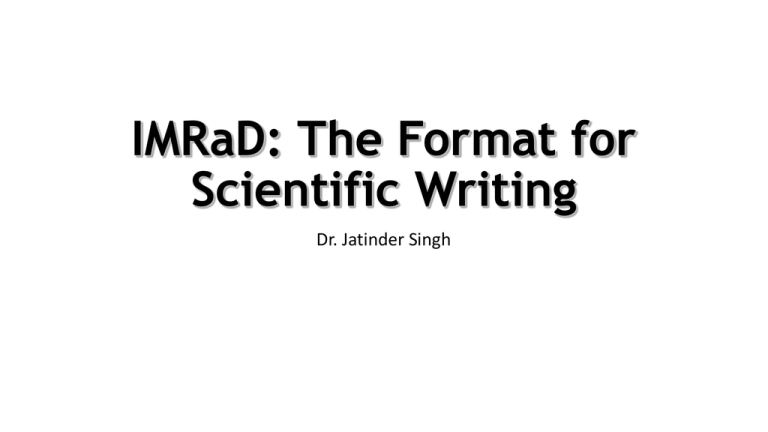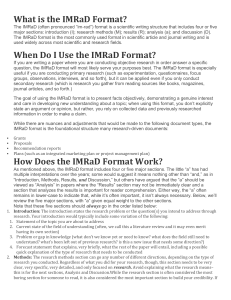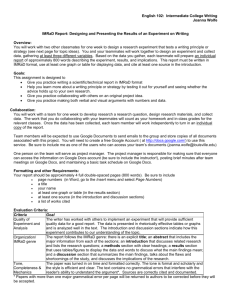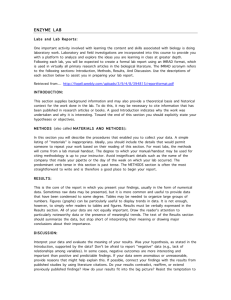IMRaD: The Format for Scientific Writing
advertisement

IMRaD: The Format for Scientific Writing Dr. Jatinder Singh ‘‘A scientific experiment, no matter how spectacular the results, is not completed until the results are published’’ (Day and Gastel, 2006) The Nobel Prize in Physiology or Medicine 1962 Publish-or Perish! All advances in science depend on the painstaking process of scientific publishing. Journal impact factors and article citations have become the catchphrases in today’s academic world. These are used increasingly to measure and evaluate the performance of research projects, journals, scientists, and institutions. Have a direct impact on promotions and furthering your career. Outcome of published work.. Provides a documentary evidence that enables the reader to: Assess the observations you have made Repeat the study/ experiment if they desire Determine whether conclusions drawn are justified by the data * How to write a paper. Hall GM (editor) Third edition. 2004 Types of Papers.. Research Paper (Original articles) Clinical investigations Laboratory investigations Short communications Letter to the Editor Rapid Communications Case Report Review Article Editorial Commentary Historical articles Book reviews / website reviews Proceedings or abstracts of meetings of scientific societies Why do we need a structure? To avoid confusion Reduce verbosity Introduce clarity Specificity Developing a structure or framework for your writing will ensure that the most important points are covered at the appropriate point in the writing. The text of observational and experimental articles is usually (but not necessarily) divided into the following sections: Introduction, Methods, Results, and Discussion. This “IMRAD” structure is not an arbitrary publication format but rather a direct reflection of the process of scientific discovery. ICMJE IMRaD IMRAD is an outcome of the evolution of scientific publishing. Scientific papers in the initial times were descriptive and chronologically written with no clear structure. As scientific writing evolved a structure developed. Louis Pasteur invented the first IMRAD-like writing structure in his classic book, Etudes sur la Biere (studies on fermentation), originally published in 1876! Structure 1. Why did you start? Introduction 2. What did you do? Methods 3. What did you find? Results 4. What does this Discussion mean? Sir Austin Bradford Hill, British Medical Research Council Advantages Provides a consistent framework that guides the author to address several questions essential to understanding a scientific study The IMRAD structure facilitates modular reading, because readers usually do not read in a linear way but browse in each section of the article, looking for specific information, which is normally found in preestablished areas of the paper The reader needs to see a building, not a pile of bricks! …..the best papers combine science…… with the art of writing’’ (Southgate 1995). Properly using IMRAD improves the art of writing as well as the communication of science. As science and information technology continue to advance, IMRAD will evolve as well. Abstract, keywords, acknowledgments, and references have become common parts of the IMRAD structure. IMRAD organisation The application of the five W’s (who, what, where, when and why) in each section of IMRAD as a way of providing more structuring. How ? What IMRaD does not cover.. IMRaD does not say anything about a paper’s title, authorship, or summary. The conclusion, acknowledgments section, and references are neglected too. But the acronym TASIMRaDCAR !! Title Abstract I Introduction What is it about ? What is it in a nutshell? Why did you do it ? Where did you do it ? M Methods How did you do it ? R Results What did you find? D Discussion What does this mean and so what? Conclusions What are your major findings and their significance? Acknowledgments References










